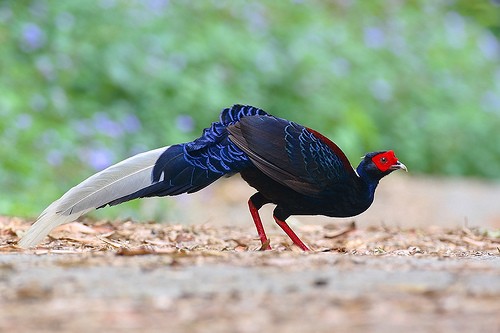Swinhoe's Pheasant
A species of Gallopheasants Scientific name : Lophura swinhoii Genus : Gallopheasants
Swinhoe's Pheasant, A species of Gallopheasants
Botanical name: Lophura swinhoii
Genus: Gallopheasants
Content
Description General Info
 Photo By José Oscar dos Santos Junior , used under CC-BY-SA-3.0 /Cropped and compressed from original
Photo By José Oscar dos Santos Junior , used under CC-BY-SA-3.0 /Cropped and compressed from original Description
The male Swinhoe's pheasant can grow up to 79 cm. He has a glossy blue-purple chest, belly and rump, white nape, red wattles, white tail feathers, and a white crest. The female is brown marked with yellow arrow-shaped spots and complex barring patterns, and has maroon outer rectrices. The juvenile male is dark blue with brown and yellow patterns on its wings. Swinhoe's pheasants can also be distinguished from the Mikado pheasant by having red legs. During display, the male's wattles become engorged and he performs a display consisting of a hop followed by running in a circle around females. A frontal display with the tail fanned is occasionally observed. He also does a wing-whirring display like other Lophura pheasants. 
Size
79 cm
Colors
Brown
Black
Green
Yellow
Red
Bronze
White
Blue
Purple
Nest Placement
Ground
Feeding Habits
Swinhoe's Pheasant, a forest-dwelling bird, predominantly feeds on seeds, fruits, insects, and diverse animal matter. It forages on the ground with a preference for dense undergrowth, adapting unique methods to access a varied diet within its habitat.
Habitat
Swinhoe's Pheasant are typically found in mountainous regions, specifically in primary broadleaf forests and mature secondary hardwood forests with dense undergrowth. The species favors elevations ranging from 300 to 2,300 meters. Their habitat spans broad geographical regions, notably including high-altitude forested zones.
Dite type
Omnivorous
General Info
Feeding Habits
Bird food type
Behavior
Swinhoe's pheasant eats seeds, fruits, and some insects and other animal matter. Predators include the crested goshawk, white-bellied sea eagle, Gurney's eagle, spot-bellied eagle-owl as well as civets and badgers. The female lays a clutch of 2 to 6 eggs which are incubated for 25 to 28 days. The young can leave the nest at 2 to 3 days old. It is often assumed the Swinhoe's pheasant is polygynous, as males are often seen with several females, though information on this assertion is lacking. 
Species Status
This pheasant has a small population in a limited range which is shrinking due to habitat degradation. Logging is a problem. It was hunted in the past and some populations were extirpated in the 1960s and 1970s. Today its global population is estimated to be over 10,000 individuals. Some populations are secure within protected areas, but others may be declining. Alongside the Mikado pheasant and Taiwan magpie, they are sometimes unofficially considered national symbols of Taiwan, which has helped in their conservation and protection. In some areas such as Dasyueshan National Forest Recreation Area, they are regularly sighted feeding along roadsides which have become birdwatching hotspots. Often they are fed by bird photographers, which has considered a controversial practice by some conservationists and liable to a fine by park officials. 

 Photo By José Oscar dos Santos Junior , used under CC-BY-SA-3.0 /Cropped and compressed from original
Photo By José Oscar dos Santos Junior , used under CC-BY-SA-3.0 /Cropped and compressed from original